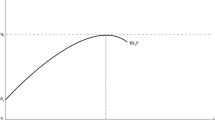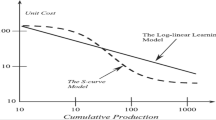Abstract
This paper models the bounded learning concept with the learning progress function characterized by the degree of efficiency and the specification of the learning progress as a logistic function capturing both the slow start-up and the limit in learning progress. We differentiate learning efficiency from the technical efficiency. The endogeneity corrected stochastic frontier model is then used to decompose the factor productivity growth into components associated with technological change, technical efficiency, scale, and learning. This productivity growth decomposition provides useful information and policy level insight in firm-level productivity analysis. Empirical results based on plant-level panel data on the Colombian food manufacturing industry for the period 1982–1998 suggest that productivity growth not only stems from technical progress, technical efficiency change, and scale but also from significant learning effect. The relative importance of the productivity growth components provides perspective for efficient resource allocation within the firm.


Similar content being viewed by others
Notes
In fact, η is a firm-specific component that can vary over time and can reflect changes in the rate of learning. But one should not necessarily exclude the prospect of firm’s unlearning or forgetting.
The differential equation representing the learning progress function of a general firm (with learning inefficiency) is \(\frac{{d{A_1}}}{{dV}} = \alpha A - \frac{\alpha }{{\bar a}}{A^2} - \eta \alpha A\), and for the best practice firm is \(\frac{{d{A_2}}}{{dV}} = \alpha A - \frac{\alpha }{{\bar a}}{A^2}\). The difference is\(\frac{d}{{dV}}\left( {{A_1} - {A_2}} \right) = - \eta \alpha A\). since A > 0, η ∈ [0, 1) and α > 0, the above derivative is always negative which proves that the function of the general firm will always be below that of the best practice firm for any value of η ∈ [0, 1).
Instantaneous learning rate α and learning inefficiency η can be estimated from this residual by representing (3) as \(\frac{{d\hat A}}{{dV}} = \alpha \hat A - \frac{\alpha }{{\bar a}}{\hat A^2} - \eta \alpha \hat A\). Using the discrete analog of the derivative term \(\frac{{d\hat A}}{{dV}} = \frac{{{{\hat A}_{it}} - {{\hat A}_{it - 1}}}}{{{{\hat y}_{it}}}}\), (3) can be written as \(\frac{{d{{\hat A}_{it}}}}{{{{\hat y}_{it}}}} = {\sum} {\left( {{\alpha _i} - {\eta _i}{\alpha _i}} \right){D_i}{{\hat A}_{it - 1}} - {\sum} {{\alpha _i}{D_i}\hat A_{it - 1}^2} } + {\varepsilon _{it}}\), where D i is a dummy variable for individual firm in a sector. Using this specification instantaneous learning rate and learning inefficiency parameters can be estimated by using the nonlinear least square technique.
References
Ackerberg D, Caves K, Frazer G (2006) Structural identification of production functions. Munich Personal RePEc Archive Paper No. 38349, posted 25 April 2012. http://mpra.ub.uni-muenchen.de/38349/
Ackerberg D, Lanier Benkard C, Berry S, Pakes A (2007) Econometric tools for analyzing market outcomes. Handb Econom Elsevier 6:4171–4276
Adler P, Clark K (1991) Behind the learning curve: a sketch of the learning process. Manag Sci 37(3):267–281
Argote L (1999) Organizational learning: creating, retaining, and transferring knowledge. Kluwer Academic Publishers, Boston, MA.
Argote L, Beckman SL, Epple D (1990) The persistence and transfer of learning in industrial settings. Manag Sci 36(2):140–154
Arrow K (1962) The economic implications of learning by doing. Rev Econ Stud 29(3):155–173
Bahk B, Gort M (1993) Decomposing learning by doing in new plants. J Polit Econ 101(4):561–583
Baloff N (1966) The learning curve—some controversial issues. J Ind Econ 14(3):275–282
Baloff N (1971) Extension of the learning curve—some empirical results. Oper Res Q 22(4):329–340
Battese G, Coelli T (1992) Frontier production functions, technical efficiency and panel data: with application to paddy farmers in India. J Prod Anal 3(1):153–169
Bauer P (1990) Decomposing TFP growth in the presence of cost inefficiency, nonconstant returns to scale, and technological progress. J Prod Anal 1(4):287–299
Benkard C (2000) Learning and forgetting: the dynamics of aircraft production. Am Econ Rev 90(4):1034–1054
Brachet T, David G (2011) On the determinants of organizational forgetting. Am Econ J Microecon 3(3):100–123
Carr G (1946) Peacetime cost estimating requires new learning curves. Aviation 45(4):220–228
Cochran E (1960) New concepts of the learning curve. J Ind Eng 11(4):317–327
Cochran E, Sherman H (1982) Predicting new product labour hours. Int J Prod Res 20(4):517–543
Conway R, Schultz A (1959) The manufacturing progress function. J Ind Eng 10(1):39–53
Darr ED, Argote L, Epple D (1995) The acquisition, transfer, and depreciation of knowledge in service organizations: productivity in franchises. Manag Sci 41(11):1750–1762
Denny M, Fuss M, Waverman L (1981) The measurement and interpretation of total factor productivity in regulated industries, with an application to Canadian telecommunications. In: T. G. Cowing & R. E. Stevenson (eds) Productivity measurement in regulated industries, Academic Press, New York
Epple D, Argote L, Murphy K (1996) An empirical investigation of the microstructure of knowledge acquisition and transfer through learning by doing. Oper Res 44(1):77–86
Griliches Z, Mairesse J (1995). Production functions: the search for identification. NBER working paper 5067
Irwin D, Klenow P (1994) Learning-by-doing spillovers in the semiconductor industry. J Polit Econ 102(6):1200–1227
Jarmin R (1994) Learning by doing and competition in the early rayon industry. Rand J Econ 25(3):441–454
Jovanovic B, Nyarko Y (1995) A Bayesian learning model fitted to a variety of empirical learning curves. Brook Pap Econ Act Microecon 1:247–305
Kim S, Han G (2001) A decomposition of total factor productivity growth in Korean manufacturing industries: a stochastic frontier approach. J Prod Anal 16(3):269–281
Kumbhakar SC (2000) Estimation and decomposition of productivity change when production is not efficient: a panel data approach. Econ Rev 19(4):425–460
Kumbhakar SC, and Lovell CAK (2000) Stochastic frontier analysis. Cambridge University Press, Cambridge, UK.
Leibenstein H (1966) Allocative efficiency vs.” X-efficiency”. Am Econ Rev 56(3):392–415
Leibenstein H (1978) X-inefficiency Xists: Reply to an Xorcist. Am Econ Rev 68(1):203–211
Leibenstein H (1979) A branch of economics is missing: micro-micro theory. J Econ Lit 17(2):477–502
Levinsohn J, Petrin A (2003) Estimating production functions using inputs to control for unobservables. Rev Econ Stud 70(2):317–341
Lieberman M (1984) The learning curve and pricing in the chemical processing industries. Rand J Econ 15(2):213–228
Lucas Jr R (1993) Making a miracle. Econometrica 61(2):251–272
Luh Y, Stefanou S (1993) Learning-by-doing and the sources of productivity growth: a dynamic model with application to US agriculture. J Prod Anal 4(4):353–370
Malerba F (1992) Learning by firms and incremental technical change. Econ J 102(413):845–859
Marschak J, Andrews W (1944) Random simultaneous equations and the theory of production. Econometrica 12(3):143–205
Mundlak Y (1996) Production function estimation: reviving the primal. Econometrica 64(2):431–438
Nishimizu M, Page JM (1982) Total factor productivity growth, technological progress and technical efficiency change: dimensions of productivity change in Yugoslavia, 1965–1978. Econ J 92(368):920–936
Oi WY (1967) The neoclassical foundations of progress function. Econ J 77(307):579–594
Olley G, Pakes A (1996) The dynamics of productivity in the telecommunications equipment industry. Econometrica 64(6):1263–1297
Rapping L (1965) Learning and World War II production functions. Rev Econ Stat 47(1):81–86
Rosen S (1972) Learning by experience as joint production. Q J Econ 86(3):366–382
Shee A, Stefanou SE (2015) Endogeneity corrected stochastic production frontier and technical efficiency. Am J Agric Econ 97(3):939–952
Stefanou SE, Saxena S (1988) Education, experience, and allocative efficiency: a dual approach. Am J Agric Econ 70(2):338–345
Stigler G (1976) The xistence of X-efficiency. Am Econ Rev 66(1):213–216
Thompson P (2001) How much did the liberty shipbuilders learn? New evidence for an old case study. J Polit Econ 109(1):103–137
Thompson P (2007) How much did the Liberty shipbuilders forget? Manag Sci 53(6):908–918
Thornton R, Thompson P (2001) Learning from experience and learning from others: an exploration of learning and spillovers in wartime shipbuilding. Am Econ Rev 91(5):1350–1368
Young A (1993) Invention and bounded learning by doing. J Polit Econ 101(3):443–472
Acknowledegments
The authors thank the associate editor, two anonymous referees, and Cindy Cox for helpful comments. We also thank Departamento Administrativo Nacional de Estadistica (DANE) for providing access to the data.
Author information
Authors and Affiliations
Corresponding author
Ethics declarations
Conflict of interest
The authors declare that they have no conflict of interests.
Appendices
Appendix 1
To solve the differential equation governing the learning progress for a general firm
Using separation of variables we get,\({\int} {\frac{{dA}}{{A\left( {\left( {\alpha - \eta } \right){\textstyle{{\bar a} \over \alpha }} - A} \right)}} = {\int} {\frac{\alpha }{{\bar a}}dV} } + c\)
Partial fraction decomposition, \({\frac{1} {\left( \alpha - \eta \right) {\frac{\bar a}{\alpha}} }} {\int} \left({\frac{1}{A}}- {\frac{1}{\left(\alpha-\eta \right){\frac{\bar a}{\alpha}}-A}}\right)dA={\frac{\alpha}{\bar a}}V+c\)
Initial condition, at V = 0, \(A = {a_0}\) hence \(k = \frac{{{a_0}}}{{(\alpha - \eta ){\textstyle{{\bar a} \over \alpha }} - {a_0}}}\)
Putting the value of k we write, \((\alpha - \eta ){\textstyle{{\bar a} \over \alpha }}{a_0}{e^{(\alpha - \eta )V}} - {a_0}A{e^{(\alpha - \eta )V}} = A\left( {(\alpha - \eta ){\textstyle{{\bar a} \over \alpha }} - {a_0}} \right)\)
Substituting η by ηα the differential equation becomes \(\frac{{dA}}{{dV}} = \alpha A - \frac{\alpha }{{\bar a}}{A^2} - \eta \alpha A\) and the solution becomes \(A\left( V_{t} \right) = \frac{{\left( {1 - \eta } \right)}{\bar \alpha} } {{1 + \frac{{\left( {1 - \eta } \right){\bar a} - {a_0} } } {a_0}}e^{-\alpha\left( l-\eta \right) V}} \)
Appendix 2
Simulated plots of the learning progress function
Rights and permissions
About this article
Cite this article
Shee, A., Stefanou, S.E. Bounded learning-by-doing and sources of firm level productivity growth in colombian food manufacturing industry. J Prod Anal 46, 185–197 (2016). https://doi.org/10.1007/s11123-016-0481-3
Published:
Issue Date:
DOI: https://doi.org/10.1007/s11123-016-0481-3
Keywords
- Colombian food manufacturing industry
- Bounded learning-by-doing
- Endogeneity corrected stochastic frontier
- Firm-level productivity growth
- Decomposition of productivity growth





